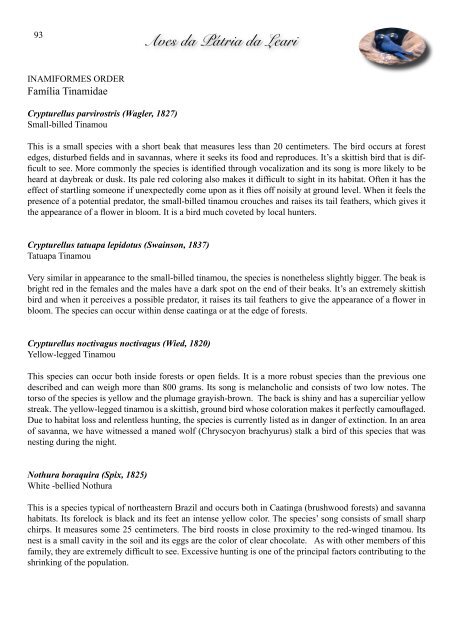Aves da Pátria da Leari - Sociedade Brasileira de Ornitologia
Aves da Pátria da Leari - Sociedade Brasileira de Ornitologia
Aves da Pátria da Leari - Sociedade Brasileira de Ornitologia
You also want an ePaper? Increase the reach of your titles
YUMPU automatically turns print PDFs into web optimized ePapers that Google loves.
93<br />
INAMIFORMES ORDER<br />
Família Tinami<strong>da</strong>e<br />
Crypturellus parvirostris (Wagler, 1827)<br />
Small-billed Tinamou<br />
<strong>Aves</strong> <strong>da</strong> <strong>Pátria</strong> <strong>da</strong> <strong>Leari</strong><br />
This is a small species with a short beak that measures less than 20 centimeters. The bird occurs at forest<br />
edges, disturbed fields and in savannas, where it seeks its food and reproduces. It’s a skittish bird that is difficult<br />
to see. More commonly the species is i<strong>de</strong>ntified through vocalization and its song is more likely to be<br />
heard at <strong>da</strong>ybreak or dusk. Its pale red coloring also makes it difficult to sight in its habitat. Often it has the<br />
effect of startling someone if unexpectedly come upon as it flies off noisily at ground level. When it feels the<br />
presence of a potential pre<strong>da</strong>tor, the small-billed tinamou crouches and raises its tail feathers, which gives it<br />
the appearance of a flower in bloom. It is a bird much coveted by local hunters.<br />
Crypturellus tatuapa lepidotus (Swainson, 1837)<br />
Tatuapa Tinamou<br />
Very similar in appearance to the small-billed tinamou, the species is nonetheless slightly bigger. The beak is<br />
bright red in the females and the males have a <strong>da</strong>rk spot on the end of their beaks. It’s an extremely skittish<br />
bird and when it perceives a possible pre<strong>da</strong>tor, it raises its tail feathers to give the appearance of a flower in<br />
bloom. The species can occur within <strong>de</strong>nse caatinga or at the edge of forests.<br />
Crypturellus noctivagus noctivagus (Wied, 1820)<br />
Yellow-legged Tinamou<br />
This species can occur both insi<strong>de</strong> forests or open fields. It is a more robust species than the previous one<br />
<strong>de</strong>scribed and can weigh more than 800 grams. Its song is melancholic and consists of two low notes. The<br />
torso of the species is yellow and the plumage grayish-brown. The back is shiny and has a superciliar yellow<br />
streak. The yellow-legged tinamou is a skittish, ground bird whose coloration makes it perfectly camouflaged.<br />
Due to habitat loss and relentless hunting, the species is currently listed as in <strong>da</strong>nger of extinction. In an area<br />
of savanna, we have witnessed a maned wolf (Chrysocyon brachyurus) stalk a bird of this species that was<br />
nesting during the night.<br />
Nothura boraquira (Spix, 1825)<br />
White -bellied Nothura<br />
This is a species typical of northeastern Brazil and occurs both in Caatinga (brushwood forests) and savanna<br />
habitats. Its forelock is black and its feet an intense yellow color. The species’ song consists of small sharp<br />
chirps. It measures some 25 centimeters. The bird roosts in close proximity to the red-winged tinamou. Its<br />
nest is a small cavity in the soil and its eggs are the color of clear chocolate. As with other members of this<br />
family, they are extremely difficult to see. Excessive hunting is one of the principal factors contributing to the<br />
shrinking of the population.

















